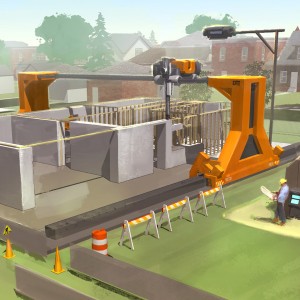Viterbi refines 3-D printer
USC Professor of Engineering and Director of the Center for Rapid Automated Fabrication Technologies Behrokh Khoshnevis has developed a three-dimensional printer that can build houses in 24 hours.

Smart House · The cost of building a house through 3-D printing would be significally lower than in the case of regular construction. – Photo courtesy of Contour Crafting
Khoshnevis created a technology called “contour crafting,” a term he coined to describe a fabrication process that allows large-scale parts to be fabricated quickly using a layer-by-layer technique.
The printer is equipped with a nozzle that spews out concrete and can build a home using a set computer pattern. This process allows a single house or a colony of houses, each customized, to be automatically constructed in a single run, with components such as conduits for electrical, plumbing and air-conditioning included.
Though this technology was developed several years ago, Khoshnevis has found a way to speed up the process by creating a printer that can produce thick layers of building material.
In the beginning of the development, it took several weeks to build a full-sized human sculpture. Now, after much research, the machine has been improved to build a 2,500 square foot house in a day.
“I’ve always been focused on ways of making things,” Khoshnevis said.
This is an example of platform technology, a technology that has applications in different domains, according to Khoshnevis. In the case of contour crafting, he feels most passionately about housing and how it can be commercialized to build houses rapidly in low-income areas.
Khoshnevis said the technology can create long-term housing and, more importantly, emergency housing in the case of natural disasters. He said about 40 million people around the world are uprooted because of disasters.
“We need a fast way of responding to those, so this [technology] is instrumental,” he said.
In addition, the cost of building a house through contour crafting would be significantly lower as there would be less labor involved than in the case of manual construction.
Other possible uses include building structures on other satellites and planets, such as the Moon or Mars. The technology has opened up this possibility due to its low cost and rapid production rate.
Though some say that this technology will lead to a reduction in jobs, the benefits will outweigh the potential disadvantages, according to Steven Nutt, chair of chemical engineering and materials science and director of the M.C. Gill Composites Center. He asserts that the prospect of customizable housing and the ability to make housing affordable are tremendous benefits.
“You can understand the appeal of the potential of the technology for construction,” Nutt said.
Khoshnevis is planning to establish a company to commercialize the technology more. He hopes to bring the basic technology to the market in order to build as many houses as needed.
Khoshnevis also predicts that it will take a few years for the product to become available for purchase.
Because there is very limited laboratory space, Khoshnevis and his team have been building small sections of the house model. The space does not allow for many models to be built to test out the improved product.
“If we build one house, we have to demolish [an existing] one,” he said.
Improvements are constantly being made, new tests conducted and building processes demonstrated.
Some of these pieces generated from the printer are currently being displayed at 10 museums around the world, including ones in New York and Spain.

Can he 3d me an extra bedroom
You can’t 3D print soul
This would certainly change everything…imagine
“You can’t 3D print soul” – What does this even mean?